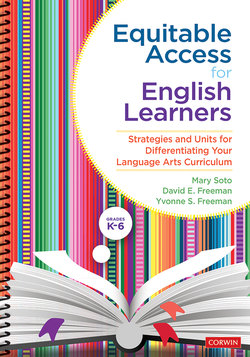Читать книгу Equitable Access for English Learners, Grades K-6 - Mary Soto - Страница 48
На сайте Литреса книга снята с продажи.
Conclusion
ОглавлениеMany mainstream teachers who have English learners in their classes are expected to teach using district-adopted language arts textbooks. These materials may include a few suggestions for working with English learners, but textbooks are written for native English speakers. Our goal in this book is to show how teachers can adopt a new approach and use strategies and key practices that make language arts units of inquiry based on big questions accessible to both native English speakers and English learners.
The key points for working effectively with emergent bilinguals that we have discussed include:
Organizing your language arts curriculum around units of inquiry
Getting to know your English learners so you can best teach them
Creating a multilingual/multicultural environment
Understanding the language proficiency of your students
Using a gradual release of responsibility model of reading and writing
Drawing on English learners’ background knowledge
Drawing on students’ home languages (translanguaging)
The goal of this book is to give you the support you need to work effectively with the emergent bilingual students in your language arts classroom, using an approach that will make your language arts curriculum accessible to all of your students. Using this approach, you will see how to include both language and content objectives connected to Standards, how to make what you teach comprehensible to all your students, and how to choose appropriate texts for your students. When you use this approach, your English learners can develop the academic language and the academic content they need for school success.
